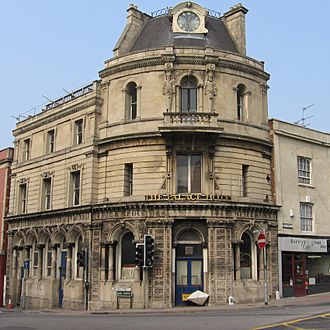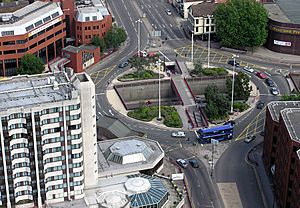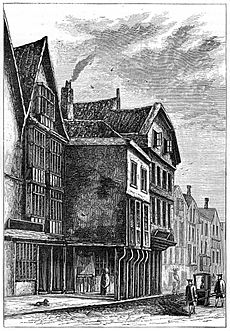Old Market, Bristol facts for kids
Quick facts for kids Old Market |
|
|---|---|

Palace Hotel, West Street
|
|
| General information | |
| Location | Bristol, England |
| Coordinates | 51°27′22″N 2°34′52″W / 51.456°N 2.581°W |
| OS grid | ST596732 |
Old Market is a special area in Bristol, England, just east of the city centre. It's known as a Conservation Area, which means its history and unique buildings are protected. The main streets here are Old Market Street and West Street. This area is roughly bordered by New Street, Lawfords Gate, Trinity Road, Trinity Street, Unity Street, Waterloo Road, and Temple Way Underpass.
Old Market Street was once a very old market place. It grew right outside the walls of Bristol Castle. For many centuries, it was part of the main road to London (now called the A420). On market days, other streets like Jacob Street and Redcross Street were used for through traffic. Old Market even had a special court called the Pie Poudre Court. This court quickly dealt with people who broke rules on market days. It wasn't officially stopped until 1971.
This area has some of Bristol's oldest buildings. This includes the last two houses that stick out over the pavement (called jettied). More than sixty buildings here are also listed, meaning they are historically important. Old Market faced tough times in the mid-20th century. Bristol's main shopping area moved from Castle Street to Broadmead. Also, new roads like Temple Way Underpass and Easton Way cut Old Market off from other parts of the city. Some important buildings still need care. However, local groups and special grants have helped restore many buildings since it became a Conservation Area in 1979.
Contents
History of Old Market
Early Beginnings
Records show that a market existed just east of Bristol Castle as early as the mid-12th century. This area had fertile land and many market gardens. From the 15th century, people started calling it 'Old Market'.
In the 13th century, a defensive ditch was dug around the area. Lawford's Gate was at the eastern end, separating Old Market from West Street. This ditch marked the edge of the town of Bristol. The land was divided into long, narrow plots, and some of these still exist today.
West Street was outside Bristol's main control. This meant it didn't have to pay local taxes. It became a place with many inns and different kinds of lodgings.
Growth and Change
Old Market Street grew as Bristol's trade became bigger. It became a street about 370 metres (1,210 ft) long. It connected the East Gate of the Castle with Lawford's Gate. The middle part of the street was wide, but it narrowed near the gates.
In the 15th and 16th centuries, the area became more important. It was home to almshouses (places for poor people), factories, houses, inns, and shops.
Old Market suffered during the English Civil War. When the Parliamentarians attacked Lawford's Gate, much of West Street might have been destroyed. Buildings east of Lawford's Gate may have been pulled down. This gave the Royalists a clear line of sight for defense. Much of the area was rebuilt after the war. Bristol Castle was demolished, and with it, the East Gate. Old Market Street and Castle Street then became a major business route. Many buildings from this time are still standing today.
Modern Era Challenges
In 1768, Lawford's Gate was taken down. This allowed Castle Street and Old Market Street to extend into West Street. Old Market became home to many different types of businesses. Wealthy people built townhouses on Old Market Street and West Street. Meanwhile, skilled workers lived in the smaller side streets.
By the late 1800s, market trading became harder due to more wheeled traffic. Old Market became an important tram stop. Trams connected it to areas east, north-west, and south of the city. It was also a well-known shopping street, linking smoothly with Castle Street.
Some parts of the area were affected by city improvement plans in the 1930s. However, the biggest challenges came from the destruction of Castle Street. Also, the building of Temple Way Underpass cut off the western end of Old Market Street. A plan to widen roads made things even worse. Many businesses moved to Broadmead or closed down. Large parts of the area were set aside for new construction, which made the area look neglected.
In the 1970s, people started to see the value of the remaining old buildings. In 1979, the area was officially made a Conservation Area. Since then, many buildings that were at risk have been restored. A more careful approach to new construction has greatly improved the area.
Important Buildings
Old Market has over 60 listed buildings. Some of these are even older than the 17th century. Famous buildings include the domed Methodist Central Hall, which is now flats. Holy Trinity Church is now a music venue and studio. Other important buildings are St Jude's Church, St Nicolas Church, and Trinity Road Library.
The Holy Trinity Almshouses were founded in 1402 and rebuilt in the mid-1800s. The Stag and Hounds Public House was once home to the Pie Poudre Court. Other notable buildings are the Palace Hotel and Gardiners Warehouse.
Other significant buildings include Kingsley Hall, a Georgian house that sticks out over the pavement. Also, 7 Redcross Street is a grand Georgian house with a fancy shell porch. However, it's often the mix of buildings that makes Old Market special. For example, at 68-71 Old Market Street, classic Georgian buildings stand next to older timber-framed houses with gables. Meanwhile, 65 Old Market Street is an old drill hall, used for military training.
Pie-Poudre Court
In Norman times, a special court was set up to quickly deal with thieves and people who owed money at markets and fairs. It was called the Pie-Poudre Court. The name comes from French words meaning "dusty feet." This was because it was a temporary court for travelers who weren't permanent residents of the town.
The court was first held outdoors under an old oak tree. The Stag and Hounds Public House was later built on this spot. It's believed the court then moved inside the inn, meeting in a room on the first floor.
This court is thought to be the last "active" Pie-Poudre Court in England. It was officially stopped by the Courts Act 1971. Even though it hadn't met since the fair ended in 1870, a special announcement was still read every year. This happened on the last day of September under the porch of the inn.
Notable People from Old Market
- Thomas Lawrence was born on Redcross Street. He became a famous painter.
- Edward William Godwin was born on Old Market Street. He was an important architect.
- Horace Batchelor had his office in Old Market. He was known for his radio advertisements.
- Cary Grant worked as a stage light operator at the Empire Theatre. He later became a famous Hollywood actor.



